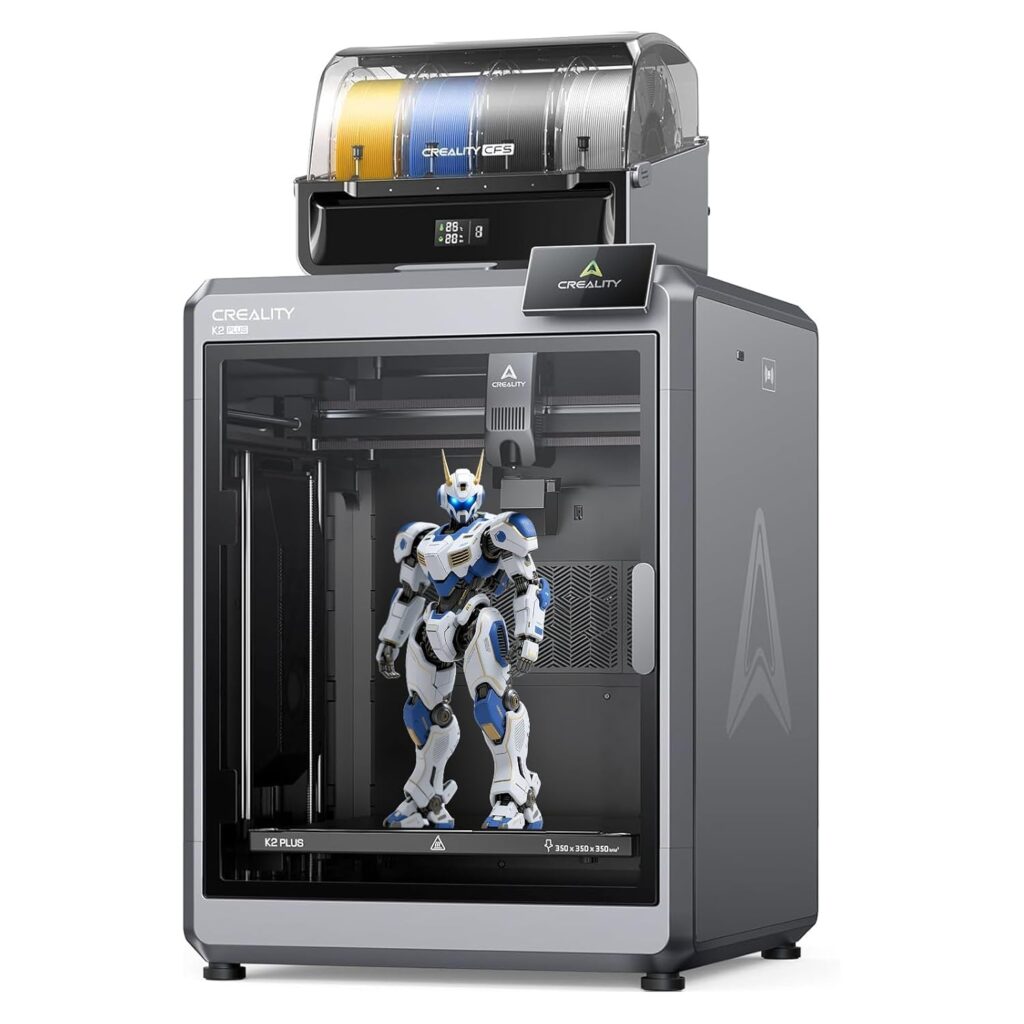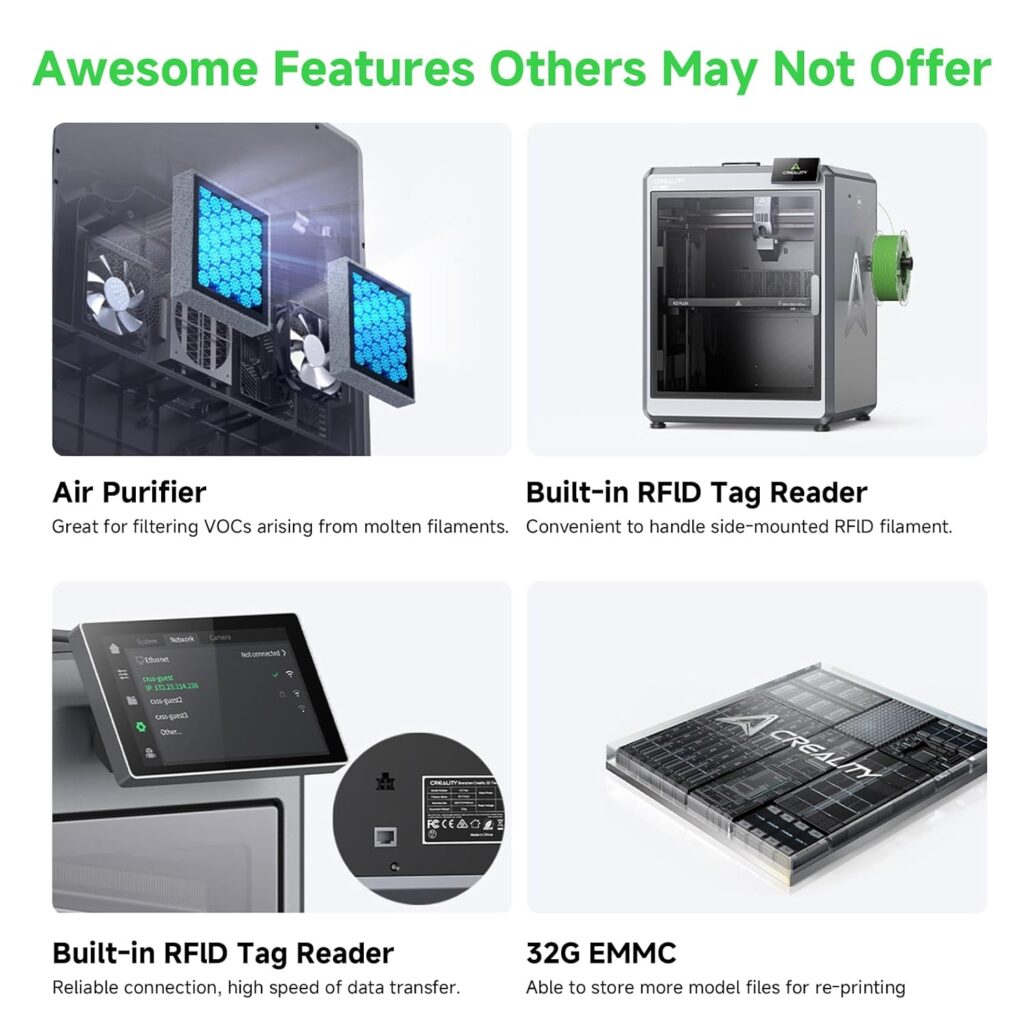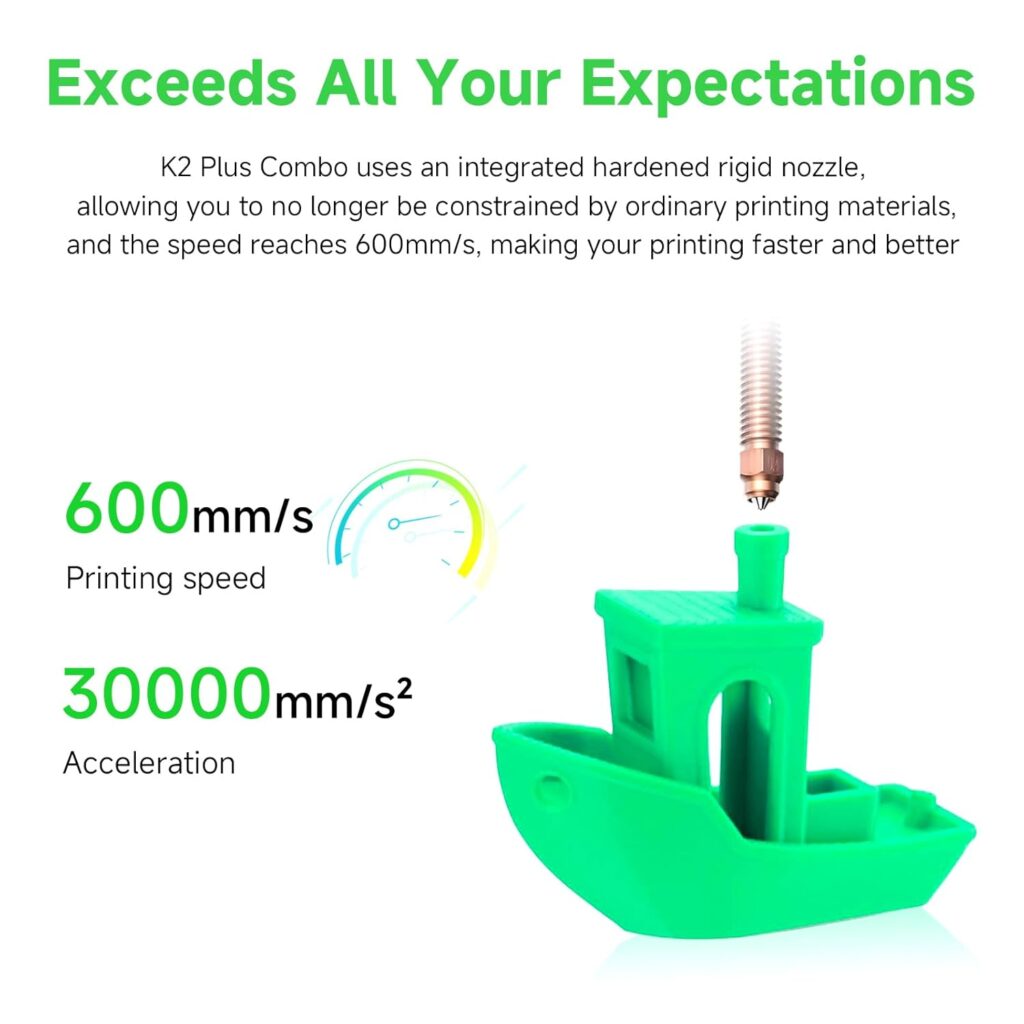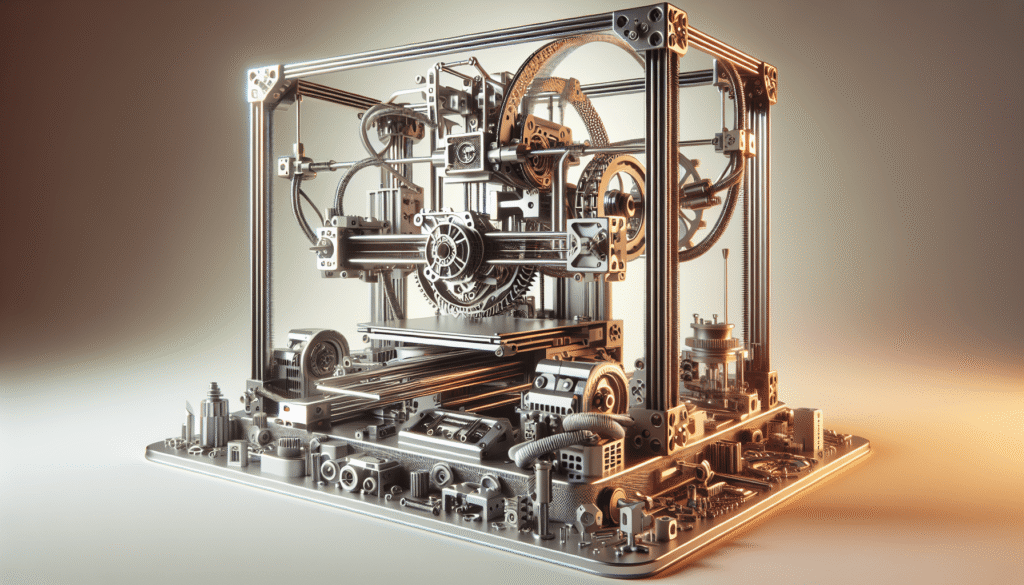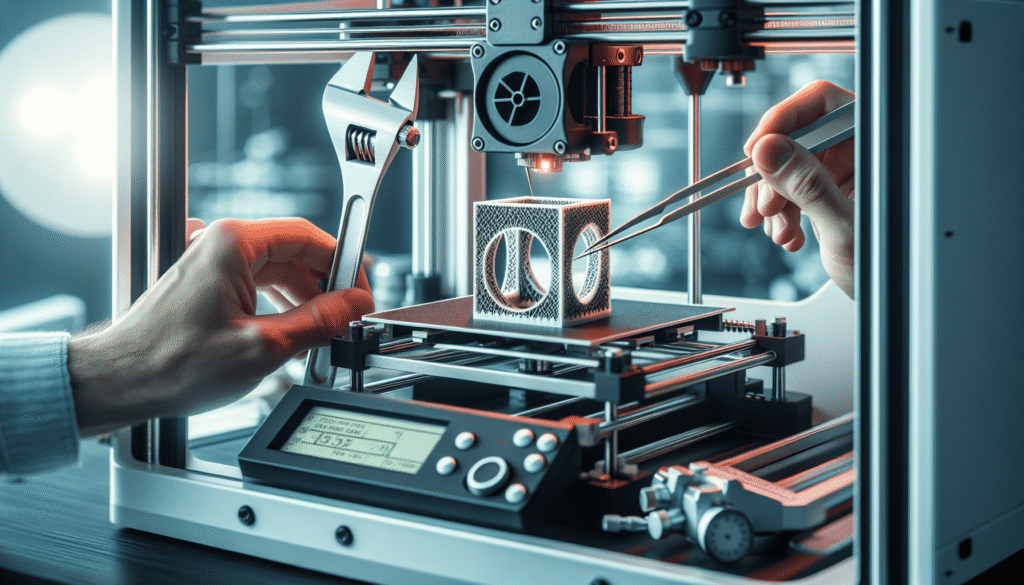What happens when a 3D printer stops behaving like a gadget and starts acting like a studio assistant that never sleeps, eats, or complains about my music choices?
Why I Chose the Official Creality K2 Plus Combo
I had my eye on a printer that could keep up with the speed of my impatience and the chaos of my color palettes. The Official Creality K2 Plus Combo promised 16-color prints, 600mm/s speeds, and AI that would watch my work like an overprotective parent—so naturally, I had to try it.
It wasn’t a casual fling. I wanted a machine that could pull off multicolor, multi-material prints without making me babysit it for hours. The K2 Plus Combo felt like a practical step up to professional-grade output, with the kind of bells and whistles I wouldn’t mind showing off.
My Background with 3D Printing
I’ve owned everything from rickety DIY kits to some surprisingly competent mid-range printers. I’ve had clogged nozzles, warped ABS monstrosities, and the occasional glorious success that made all the troubleshooting worth it. My standards are picky because my time is not infinite, and my patience is submit-to-gravity fragile.
Multicolor printing, in particular, has burned me before—manual filament swaps felt like trying to plate spaghetti while juggling cats. The promise of an integrated system that could handle colors and materials intelligently made me cautiously optimistic.
What Caught My Eye
Let me be honest: the promise of up to 16 colors in one print, managed by an automatic filament system, was the glittery lure. Throw in a heated chamber up to 300°C, a hardened steel nozzle, and a build volume of 350x350x350mm, and it started reading like a wish list I didn’t realize I had.
And then there was speed—600mm/s with 30,000mm/s² acceleration. I’ve waited hours for prints that felt more like therapy than production; the K2 Plus Combo teased me with the idea of actually meeting deadlines.
Official Creality K2 Plus Combo 3D Printers, Multicolor Printing Machine Up to 16 Colors, 600mm/s High-Speed Printing, Dual AI Camera for Monitoring, 350x350x350mm Build Volume& Filament System
$1299 In Stock
Unboxing and First Impressions
Opening the box felt like a sober Christmas. Everything was packaged with a certain seriousness that said, “You are not assembling a toy.” I appreciate good foam; it’s adulthood’s velvet.
The frame is heavy-duty and reassuring, in that “I should probably lift with my knees” way. The components looked refined, the cables were neat, and there was no smell of cheap plastic that used to haunt my earlier 3D printer days.
Build Quality and Design
The K2 Plus Combo uses a heavy-duty matrix frame with dual linear Z-axis rods. It looks industrial, and not in the ironic, loft-apartment sense—more like a machine that means business. The motion felt smooth right out of the box, like someone had actually tested it.
The overall design balances access and protection well. Panels are clean, the wiring is tucked away, and the CFS (Creality filament system) integration doesn’t look like an afterthought. I felt like I could keep this on a bench without it dominating the entire workshop.
Footprint and Build Volume: 350x350x350mm
I’ve worked with large-format printers before, and they often demand the square footage of an extra bedroom. This one fits comfortably on a sturdy table and gives me a build volume of 350x350x350mm—a sweet spot for helmets, busts, functional jigs, and medium-sized robotics assemblies.
The best part is that the usable space doesn’t feel like polite fiction. The dual linear Z rods and stiff frame keep the accuracy consistent across the entire bed, which matters when you want your corners to match your center.
Setup Experience and Calibration
Setup was pleasantly un-dramatic. I updated the firmware, connected to Wi-Fi, ran the guided calibration, and it handled the boring arithmetic of bed leveling like a stoic accountant. Anti-tilt dual Z-axis leveling plus strain-gauge bed sensing did their job without fanfare.
I’ve been guilty of skipping first layers in manual calibration out of pure hubris. Here, the K2 Plus Combo practically refused to let me sabotage myself. The first layer success rate felt close to the claimed 99%—and on a big bed, that’s the difference between printing and pacing.
Multicolor Magic: 16-Color Multi-Material Printing
This is where things got interesting. The K2 Plus Combo supports up to 16 colors with expandable CFS units (four filaments per unit, working in concert). If you’ve ever swapped filaments mid-print, you know that doing it well is like trying to coax a cat into a bathtub. This system spared me the pleading.
I queued up a multicolor logo plate and a detailed figurine with accents in five colors, and it handled the transitions with surprising maturity. Not perfect on the first go, but definitely “show-to-humans” good.
Creality Automatic Material System and CFS Units
The Creality Automatic Material System managed four filaments simultaneously with automatic cutting, loading, and purging. I didn’t need to hover and micromanage like a nervous sous chef; it handled the routine parts.
Filament routing is clean, and the auto-cutters kept the tips consistent, which is critical for repeatable loading. Expanding to more than four colors is straightforward with additional CFS units, and I never felt like I was piecing together a science project.
Color Fidelity and Transitions
Transitions between colors were cleaner than I expected for a machine pushing speed. There was a modest prime tower and some clever purging logic that reduced waste compared to my other setups. The result was sharp color boundaries and minimal bleed—with settings tuned, I’d proudly hand over the prints without explaining them in a guilty whisper.
For multicolor logos, signage, and decorative elements, it handled the complexity without melting the crispness. The only real artifact I saw early on was slight ghosting on transitions with ultra-bright pigments, which went away after optimizing purge volumes.
Multi-Material Use Cases (PA-CF, PLA-CF, ASA, etc.)
This machine isn’t just about pretty colors. The 300°C actively heated chamber and hardened steel nozzle let me use materials I usually reserve for more specialized setups. I printed PA-CF brackets, PLA-CF aesthetic parts, ASA outdoor fixtures, and a handful of exotic blends without the warping drama.
Combining a rigid carbon fiber nylon with softer TPU for gaskets became a practical design choice rather than a fantasy. For automotive clips and small aerospace-style parts that need dimensional stability, the K2 Plus Combo was more capable than I expected at this price.
Speed and Precision: 600mm/s, 30,000mm/s² Acceleration
If you’ve suffered through 60mm/s prints on big frames, 600mm/s feels like time travel. The K2 Plus Combo’s motion system doesn’t just sprint; it accelerates like it’s late for a flight—30,000mm/s² is not a gentle tap, it’s a shove.
Importantly, the precision held up. Dimensional checks showed good consistency, and with the chamber active, even the finicky plastics stayed in line. Compared to my “standard” large-format printers, it was easily 2–3X faster with comparable or better surface finish.
Step-Servo Motor System and 40mm³/s High-Flow Hot-End
It’s not just stepper motors; the step-servo motor system provides more accurate motion control at speed. That, combined with a 40mm³/s high-flow hot-end, kept extrusion consistent even on bulky, fast jobs that would choke polymer flows on lesser machines.
Layer lines were tighter than I anticipated, and the dreaded under-extrusion stripes that sometimes show up on fast layers were blessedly absent after tuning.
Surface Quality at Speed
Printing fast usually means choosing between fuzzy skins or ghosting. Here, the surfaces came out impressively clean for the speed class, particularly with PLA-CF and ASA. High-flow systems can get sloppy, but I found a sweet spot where the layers stacked neatly and corners remained crisp.
I still slowed down for ornamental pieces where I wanted the satin smoothness of an art object. But for functional parts—the kind that live in the garage or under a desk—the fast profiles were more than acceptable.
Comparison to Other Large-Format Printers
Against my other large-format printers, the K2 Plus Combo looked like it had taken an espresso and read a manual. It completed jobs much faster without leaving me with a cleanup bill. That was the actual surprise: speed without a trash bag full of failed experiments.
Large prints that would normally require an overnight run started wrapping up closer to dinner. That changes how I plan my day.
Advanced Materials and Heated Chamber to 300°C
The actively heated chamber up to 300°C brings a level of predictability to materials that otherwise warp, curl, or file for divorce mid-print. Nylon variants, ASA, and other engineering filaments need that consistent thermal environment, and this machine provides it.
I printed PA-CF motor mounts and board enclosures that used to require megadose brims and luck. Now they emerged with square corners and a reassuring sense of order, like they had attended a boot camp for polymers.
Hardened Steel Nozzle and Wear
The hardened steel nozzle was a welcome standard feature. Carbon fiber and glass-filled filaments will chew through brass nozzles like candy. After several kilograms of PA-CF and PLA-CF, I saw no visible degradation in line width or surface texture.
For aesthetic detail work where I want ultra-smooth surfaces, I might swap to a plated copper nozzle, but for the everyday mix of strong and pretty, the hardened steel tip hits the practical balance.
Warping and Chamber Benefits
I didn’t need ABS-style glue rituals or hysterical brim geometry with the chamber engaged. Warping dropped significantly, and first layers bit down like the machine meant it. Drafts are the enemy of high-temp prints; the enclosure shrugged them off.
As a result, I could rely on prints finishing the way they started, which meant fewer re-slices, fewer restarts, and fewer philosophical monologues directed at plastic.
AI, Smart Self-Correction, and Monitoring
Dual AI cameras watch the print with a diligence I haven’t had since my first dog learned about squirrels. They identify spaghetti failures, foreign objects, idling, and other shenanigans that would otherwise turn filament into modern art.
I’m not normally a fan of buzzwords in printers, but this felt more like a guardian feature than a checklist item. It saved me twice in the first week by pausing when something went off-kilter.
Dual AI Cameras: Spaghetti Detection and More
The cameras picked up early signs of failure and paused the job, which kept minor mishaps from escalating into snarls. The alert system pinged me on my phone, which meant I could start fixing problems before they got glue-gun bad.
Timelapses were a fun bonus, but for me, the practical advantage was not coming back to a failed tower and a pile of extruded noodles.
Bed Leveling: Anti-Tilt Dual Z, Strain-Gauge Sensing
The anti-tilt dual Z-axis system kept the gantry square without my intervention. Combined with strain-gauge bed sensing, first layer calibration was precise and repeatable. I could move between materials without playing the guessing game of “how much squish is too much.”
Week after week, that bed stayed level. I still ran the occasional quick check out of habit, but the machine didn’t make it my problem.
First-Layer Success Rate in Practice
Whether it’s the firmware, the sensors, the mechanics, or the subtle threat of AI cameras, first layers stuck. I hit the advertised near-99% first-layer success rate, and on a bed this size, that’s more than convenience—it’s production-grade sanity.
I stopped checking the first layer like a nervous parent during a kindergarten play. That alone made the machine feel like a partner rather than a pastime.
Stability and Reliability for Long Prints
Long prints mean hours of commitment. The heavy-duty matrix frame, dual linear Z rods, and overall build quality kept things steady across multi-day runs, which is where cheaper frames normally reveal their secrets and start rattling like windows in a storm.
For functional parts, repeated accuracy matters more than a single beautiful print. I got consistency without having to retune between big jobs.
Heavy-Duty Matrix Frame and Dual Linear Z Rods
Structural rigidity is the unglamorous hero of large-format printing. The frame and dual rods resist twist and sag, and the motion system stays aligned through long journeys. Corners stayed square, and tall parts didn’t wobble their way into tragedy.
That sense of stability is something you feel instantly. The gantry moves cleanly, quietly, and doesn’t translate speed into chatter.
Filament Runout Sensors and Auto-Cutters
Runout sensors on each filament path, combined with the auto-cutters, meant I didn’t babysit spools. When a filament ran out, the system paused gracefully and made recovery feel like a feature, not a sigh.
For multicolor jobs, the auto-trimming kept transitions cleaner and loading more reliable. This is the kind of detail that makes multicolor practical instead of theatrical.
Power Loss Recovery and Long-Run Behavior
While I didn’t plan any blackouts for science, I did test recovery. It resumed with only a faint seam where it picked up—not ideal for showroom pieces, but fine for functional parts. The chamber also recovers heat quickly, so layers didn’t suffer as much as I feared.
Across long jobs, thermal stability and motion repeatability made me relax. That’s a rare feeling in the 3D printing world.
Software, Workflow, and Slicer Settings
I worked with the recommended profiles and then tweaked for what I care about: strong first layers, tight overhangs, and clean transitions. I prefer predictable systems over mysterious magic, and the K2 Plus Combo’s profiles gave me a sturdy starting point.
Remote control and monitoring through the built-in platform made day-to-day life easier. I could slice on the laptop, send jobs over Wi-Fi, and check progress without physically hovering.
Profiles and Tuning
The out-of-the-box profiles for PLA-CF, ASA, and PA-CF were competent and didn’t need heroic intervention. I fine-tuned flow for certain filaments and adjusted acceleration for delicate details, but the core parameters felt grounded in real-world testing.
For multicolor prints, purge volumes and transition towers required a little massaging based on filament pigments. Once dialed in, the workflow felt pleasantly boring—which is exactly what I want from a production machine.
Network Features and Remote Monitoring
Wi-Fi connectivity and the dual AI cameras meant I could watch my prints and catch issues while pretending to be productive at other tasks. Job control, temperature charts, and alerts kept me in the loop without camping next to the printer.
I didn’t have to shuffle SD cards like relics from a reunion tour. That convenience adds up over time.
Noise, Maintenance, and Everyday Living
Even high-performance machines need to fit into the unruly ecosystem of real life. The K2 Plus Combo’s noise profile was reasonable for its class. It’s not whisper-quiet, but it’s less intrusive than many large-format rigs I’ve known.
Maintenance didn’t feel like a second job. Regular upkeep and occasional nozzle swaps kept things humming, and nothing felt fragile or overly precious.
Noise Levels
At speed, the motion system makes its presence known, but the tones are more mechanical hum than angry robot revenge. Inside an enclosure, the noise is further contained, and in a separate workspace, it fades into the background.
I ran several long prints overnight without waking up to any accusations from neighbors or roommates. Win.
Maintenance: Nozzle, Belts, Lubrication
The hardened steel nozzle took a beating from abrasive composites like a champ. Belts held tension consistently, and the motion system stayed smooth with periodic lubrication. Keeping the CFS pathways dust-free and the cutter blades clean made multicolor transitions more reliable.
Filters and chamber care were straightforward. It’s the kind of maintenance that settles into routine instead of therapy.
Spare Parts and Support
Creality’s ecosystem makes parts discoverable, and the modular design means fewer mysteries if something needs attention. I found documentation useful enough to get me out of mild trouble without calling the helpline like a sitcom protagonist.
Replacement nozzles and spares are easy to source. That matters in the long run more than I care to admit.
Safety, Education, and Family-Friendly Use
This machine can be a fantastic educational tool if you’re mindful. It’s not a toy—it has hot parts, moving parts, and a certain appetite for attention—but used responsibly, it can inspire the kind of curiosity that steamrolls screen time.
I used it for simple geometry projects, design challenges, and art experiments that would have melted my brain in the pre-3D era. Watching an idea become an object never gets old.
Educational Projects I Tried
I printed a set of multicolor learning tiles for math patterns, a segmented topographic map, and a kinetic sculpture that didn’t look like it wanted to hurt anyone. The color capabilities made instructional pieces more engaging, and the speed meant projects finished before interest expired.
With that big 350x350x350mm build volume, I could print entire kits in one run. No cliffhangers for the impatient.
Safety Practices with Heated Chamber
The chamber can reach high temperatures, so I treat it like an oven with personality. Doors closed during prints, ventilation on, and no reaching in for “just a second” adjustments. These rules aren’t negotiable, especially if kids are in the room.
Supervision, clear boundaries, and a healthy respect for hot metal kept everything uneventful in the best way.
Cost of Ownership and Value
Speed and reliability can save more than marketing departments let on. When prints finish faster, I spend less time rescheduling my day around them. When they succeed more often, I waste fewer spools and fewer evenings explaining my life choices to a tangle of filament.
The K2 Plus Combo isn’t budget-tier, but for multicolor, multi-material, production-leaning work, it earns its place.
Filament Costs for Multicolor Jobs
Multicolor jobs do consume more filament. Purge towers and transitions aren’t free, especially with complex pieces. That said, smart purging and sane transitions cut waste compared to my earlier experiments with less integrated systems.
I factor the extra material into the price of beauty. For client-facing pieces or display prints, the color clarity more than justifies it.
Electricity and Time Savings with 600mm/s
Faster prints mean fewer hours of heated chamber time, and that adds up on energy bills. More importantly, finishing prints 2–3X faster than my other large-format machines reshaped my schedule. I could iterate in a day instead of a week.
That velocity is hard to go back from, like discovering your bike had a secret motor.
Pros and Cons
No machine is perfect, even one that makes me a little giddy. The K2 Plus Combo nails speed, stability, and multicolor practicality, and it leaves a few corners for nitpicking.
Still, the balance tilts decisively positive, particularly if you value your time and your sanity.
What I Loved
- 16-color printing that feels manageable, not theatrical.
- 600mm/s speeds with 30,000mm/s² acceleration that deliver real-world gains.
- A 300°C actively heated chamber and hardened steel nozzle that open the door to PA-CF, PLA-CF, ASA, and more.
- Dual AI cameras that prevent spaghetti disasters and catch idling or foreign objects.
- Anti-tilt dual Z-axis leveling and strain-gauge sensing that give first layers their dignity back.
- Stable frame and dual linear Z rods that keep prints consistent across the 350x350x350mm volume.
- Filament runout sensors and auto-cutters that make long, multicolor prints practical.
What I’d Change
- Purge waste can still feel painful on color-heavy models—smarter multi-material slicing strategies help, but physics asks a fee.
- While it’s relatively quiet for what it is, a silent mode for late-night runs would be welcome for small apartments.
- The first few days have a learning curve for color transitions and purge optimization; a handholding wizard inside the UI would be fantastic.
Who Should Buy the Official Creality K2 Plus Combo
If you want professional-grade output with multicolor and multi-material capability, and you value speed that doesn’t tear quality apart, this machine fits. If you want tiny trinkets and occasional PLA prints, it’s probably more power than you need.
For makers who sell prints, educators with ambitious projects, and small businesses doing prototypes that must look sharp and survive handling, the K2 Plus Combo has the right mix.
Hobbyists vs Pros
Hobbyists who care deeply about finish and color will enjoy not hacking together solutions that ruin weekends. Pros who need to hit deadlines and present parts that look like products rather than prototypes will appreciate the speed and reliability.
Even if you only use two or three materials most days, having the other colors loaded and ready saves time and keeps you from rummaging for spools like a gremlin.
Artists, Educators, and Small Businesses
Artists benefit from true multicolor layering without post-print painting. Educators get fast throughput and safer management with the chamber and cameras. Small businesses get predictable, repeatable quality on a platform that doesn’t tremble when asked to make something tall.
It’s a broad tool that feels purpose-built for several worlds at once.
Tips, Tricks, and Real-World Results
A little initial tuning paid dividends. I adjusted purge volumes for bright pigments, favored slightly hotter first layers for PA-CF, and kept my bed clean enough to eat off (figuratively—please don’t eat off your printer).
My best results came from treating it like a serious machine: good spools, consistent drying, and profiles that respect the laws of thermomechanics.
My Favorite Prints and Settings
- A five-color company sign with crisp boundaries and no paint required, printed in under five hours where I’d normally budget two days.
- A set of PA-CF brackets for a drone frame—strong, flat, and dimensionally stable with the chamber at temperature and slow outer walls.
- A whimsical desk sculpture with metallic PLA and translucent accents that would have been impossible without reliable transitions.
I lean on moderate speeds for outer layers and let the machine fly on infill. That balance keeps surfaces pretty without turning prints into marathons.
Troubleshooting Moments I Had
I had one early clog because I treated a woodfill like an everyday filament. Dry your materials and respect abrasive blends. I also battled a slight seam line on a multicolor vase until I tuned wipe and coast—it disappeared like an apology note.
A single false AI detection paused a job when a stray thread confused the camera, but after adjusting my purge settings, it didn’t return. I’ll take one overly cautious pause over a spaghetti apocalypse any day.
Specs and Feature Breakdown at a Glance
Sometimes it helps to see the essentials without poetry. Here’s how the Official Creality K2 Plus Combo 3D Printers, Multicolor Printing Machine Up to 16 Colors, 600mm/s High-Speed Printing, Dual AI Camera for Monitoring, 350x350x350mm Build Volume & Filament System stacks up in practical terms.
| Feature | What It Means | Why It Mattered to Me |
|---|---|---|
| 16-Color Multi-Material Printing (via expandable CFS units) | Up to 16 colors in a single print, with automated filament management | True color models without manual swaps or painting; production-ready multicolor signage and models |
| Creality Automatic Material System (4 filaments per unit) | Automated loading, cutting, purge management | Fewer interruptions; smoother transitions and less failed handoffs |
| 600mm/s Speed, 30,000mm/s² Acceleration | High-speed motion with rapid ramps | Jobs finished 2–3X faster than my typical large-format setups |
| 40mm³/s High-Flow Hot-End | Consistent extrusion at speed | Maintained quality on large, fast prints without starvation |
| Step-Servo Motor System | Enhanced positional accuracy | Clean corners and reliable dimensions even when moving fast |
| 350x350x350mm Build Volume | Big enough for helmets, jigs, enclosures | Printed larger assemblies without splitting as often |
| 300°C Actively Heated Chamber | Stable thermal environment | Warping resistance for PA-CF, ASA, and other high-temp filaments |
| Hardened Steel Nozzle | Abrasion-resistant tip | Survived PA-CF and PLA-CF without premature wear |
| Dual AI Cameras | Spaghetti detection, foreign object detection, idle detection | Saved time and material by catching failures early |
| Anti-Tilt Dual Z + Strain-Gauge Bed Sensing | Automated, precise first-layer calibration | Near-99% first-layer success in practice |
| Heavy-Duty Matrix Frame + Dual Linear Z Rods | Structural rigidity and smooth motion | Consistent quality across the entire bed and tall prints |
| Filament Runout Sensors + Auto-Cutters | Automated recovery from empty spools | Multi-day, multicolor prints without babysitting |
| Software & Connectivity | Network printing, remote monitoring | Smooth workflow from laptop to printer with realtime oversight |
Each spec is only as good as the way it changes daily use. On this machine, the features didn’t read like buzzwords; they stitched together into a platform that got out of my way.
Final Thoughts
I came to the Official Creality K2 Plus Combo looking for a reliable way to print fast, in color, and with materials that don’t always behave like kindergartners. I found a machine that actually feels built for that job, not a patchwork contraption that promises everything and delivers a shrug.
Is it perfect? No. Purge waste is a fact of multicolor life, and there’s some tuning for color transitions if you’re mixing pigments like a painter. But the trade-offs are reasonable, and the wins are daily. I can send a complex print and expect it to look like I meant it, on a timeline that doesn’t swallow my week.
Between the 16-color capability, the 600mm/s speed with that brash 30,000mm/s² acceleration, the 300°C heated chamber, and the dual AI cameras standing guard, I finally feel like I’m running a small-batch production shop rather than a tinkerer’s workshop. For anyone who wants multicolor, multi-material printing at a professional clip, with a build volume that actually lets you think big, the K2 Plus Combo earns its ambitious name. It made me faster, it made me braver with materials, and it made my work feel finished—without having to apologize for the process.
Disclosure: As an Amazon Associate, I earn from qualifying purchases.
